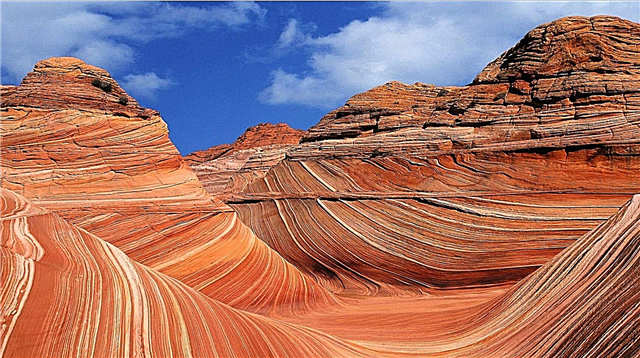
The Red Sea is the salty, warmest and cleanest sea in the world. The Red Sea is located between the East African coast and the Arabian Peninsula with a length of 2350 km, an average depth of 490 m.
Rivers do not enter the Red Sea; therefore, the reservoir is famous for the azure waters of crystal clearness. Obviously, the name of the sea has nothing to do with the color of its turquoise waters, but why is it called the Red Sea?
Interesting Facts:The Red Sea is the first in terms of salt concentration among the oceans of the World Ocean: 41 g of salt per 1 liter of water, which exceeds the salinity of the Baltic Sea (5 g of salts), the Black Sea (18 g of salts) and even the open ocean (34 g salts). In addition, due to the tropical climate off the coast of Egypt, the Red Sea is very warm: in summer, the water heats up to +27 degrees, and in winter, the water temperature is not less than +20.
There are different theories about how the Red Sea, which is located between Africa and Asia and represents the entrance to the Indian Ocean, was given the following name: biological, historical, biblical, geological, etc.
Red algae

A popular hypothesis about the emergence of the name of the Red Sea was formed by biologists. It lies in the fact that the Red Sea became known as Red in connection with Trichodesmium erythraeumthat grow near the water surface.

Algae contain an excessive amount of red pigment called “phycoerythrin,” and when seasonally propagated, they cause water to bloom, staining the light blue sea with a red-brown color.However, the red color from the flowering of algae is not intense and in large volumes of water it changes. This natural phenomenon is rare, therefore, other hypotheses for the emergence of the name of the Red Sea are considered.
Eritrean Sea
The historical hypothesis about the appearance of the name of the Red Sea is that in ancient times the sea bore the name "Eritrean", which came from the name of the founder of the city of Eritrea, King Eritre (other Greek: erythros - red). This name was used by the ancient Greek scientist Herodotus (5th century), later the ancient geographer Agatharchid (2nd century) described the reservoir in his work "On the Red Sea (Eritrea)." Eritrea - a state in East Africa - is located on the Red Sea coast.
Some researchers suggest that the Red Sea is named after the Semitic people “himyarites,” which during the second millennium. - VI century n inhabited the coast in southern Arabia. The proper name of the tribe consisted of three consonants h, m, r, which the Arabs deciphered as ahmar (from Arabic - “red).
Reed sea

The Red Sea is referred to in the Bible as the “Reed Sea” through which the prophet Moses passed from Egypt to Israel. In the biblical story of the Exodus, the sea parted and missed Moses and the Jewish people, and then closed back and destroyed the Pharaoh's army. Reeds and reeds do not grow on the Red Sea, so it is assumed that the name came from reed beds in the Gulf of Suez. In the 16th century, the sea was also called the Suez.
Interesting fact: Hydronym "Red Sea" is common only in European languages. In Hebrew, it sounds Yam Suf, which translates as “Reed Sea”, or “Reed Sea”. The Egyptian name for the sea is Vazi-VR, meaning "Green Expanse."

South sea
In ancient languages, colors were used to indicate cardinal points: green, white, black and red colors meant east, west, north and south, respectively; i.e., the Red Sea refers to the south, and the Black Sea refers to the north. Thus, according to this theory, the hydronym "Red Sea" - a designation of the location of the sea in relation to the ancient Mediterranean world - south of the Mediterranean Sea. Hence the other name of the reservoir - “Sea of the South”, or “South Sea”.
Red earth
The name of South Palestine in Hebrew is Edom, which means red. The Red Sea is divided in the northern part into the Gulf of Aqaba and the Gulf of Suez. The name was originally applied to the Gulf of Aqaba, bordering the land of Ed, the so-called "red land". So, the sea, which borders the land of Edom, was called the Red Sea.
Red rocks, corals
Geologists suggest that the Red Sea was named by sailors because of the red rocks of Harey Edom, which surrounded the reservoir. Indeed, in some parts of the sea coast, mineral cliffs of a red tint extend, due to the increased iron content.

Another idea of the name of the Red Sea is associated with the color of coral in the sea. In the ecosystem of coral reefs of the Red Sea, 1.2 thousand species of fish were found; 10% of them are endemic, i.e.inhabitants of the Red Sea exclusively. Because of the clear waters, the vibrant underwater world creates an effect in which the sea looks red from above.
Thus, there are many theories about the origin of the name of the Red Sea, and each of them makes sense: perhaps the name comes from the name of the ancient Semitic people “himyarites” who inhabited the coast; or from the southern location of the sea, since in ancient times of the Mediterranean the south was marked in red, which determined the name of the reservoir. However, the most common is the scientific-natural theory, according to which The Red Sea was dubbed the Red Sea through seasonal reddening of the water caused by the flowering of red algae near the sea surface.
Some researchers believe that the name of the salty, warmest and cleanest sea has become fixed in world geography under the influence of several factors simultaneously.












